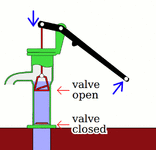Here's something else to think about.
Assumed constants:
1) a mixed bed resin has a 50/50 split between cation and anion resin.
2) anion resin is exhausted twice as fast as canion
3) mixed bed resin is $13.49 per refill, anion is $15.99, and cation is $16.49 (all individual refill bags)
4) each additional new canister is $29.99, and the refillable insert for the resin is $7.99, or $37.98 for both
So, let's say that in a twelve month period, you burn through two anion and one cation. Using the first assumption, that means that in the twelve month time frame, you would exhaust four mixed bed refills to remove the same amount of anion, and every time you refilled the mixed bed, then only half of the cation would be exhausted. That means that half of the 50% cation would be good resin that you throw in the trash, aka you're wasting 25% of the mixed bed chamber every time you refill. So, in the same time that you would refill two anion, and one cation chamber, you have to refill four mixed bed chambers to effectively remove the same amount of TDS from your water. I burn through a refill of mixed bed resin about every three months, so this calculation definitely applies to my situation, and means I would need two anion and one cation per year.
I did a breakdown of the time it would take to recoup the initial cost of adding additional chambers versus the savings you get by switching to anion/cation in comparison to just using a single chamber of mixed bed resin. I have a spreadsheet that shows the breakdown, and all the equipment prices are based off of BRS prices. I broke it into two categories: starting with a single DI resin chamber already versus starting with none. Again, these projections are based off of a twelve month window. If you change your resin out more often then the initial investment recoup time would decrease. If you change your resin out less frequently, then it would take longer to recoup the investment. These projections are based off of a twelve month time frame where you would change the mixed bed four times or the 2:1 equivalent of anion and cation. It's a very high demand situation, considering I go through about 225 gallons of RODI water per month. If you make about half as much water per month as I do, then double the time it takes to recoup your investment. Here are the different time frames it would cost to recoup the initial investment: (you save $5.49 per 12 months with my exhaustion/consumption rate)
STARTING WITH NO DI RESIN CANISTERS
ADDING A SINGLE CANISTER WITH MIXED BED
Initial investment plus 12 month supply
-$116.95
ADDING A DUAL CANISTER WITH ANION/CATION
Initial investment plus 12 month supply
-$128.46
Time to recoup initial investment
-2.10 years
ADDING A TRIPLE CANISTER WITH ANION/CATION
Initial investment plus 12 month supply
-$166.95
Time to recoup initial investment
-9.11 years
STARTING WITH A SINGLE DI RESIN CHAMBER
ADDING NO CANISTER WITH MIXED BED
Initial investment plus 12 month supply
-$53.96
ADDING A SINGLE CANISTER WITH ANION/CANTION
Initial investment plus 12 month supply
-$111.46
Time to recoup initial investment
-11.47 years
ADDING A DUAL CANISTER WITH ANION/CATION
Initial investment plus 12 month supply
-$141.95
Time to recoup initial investment
-14.57 years














